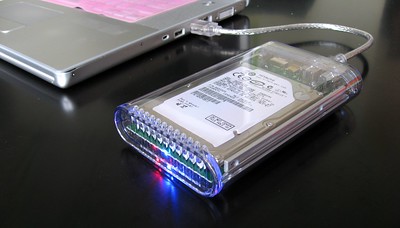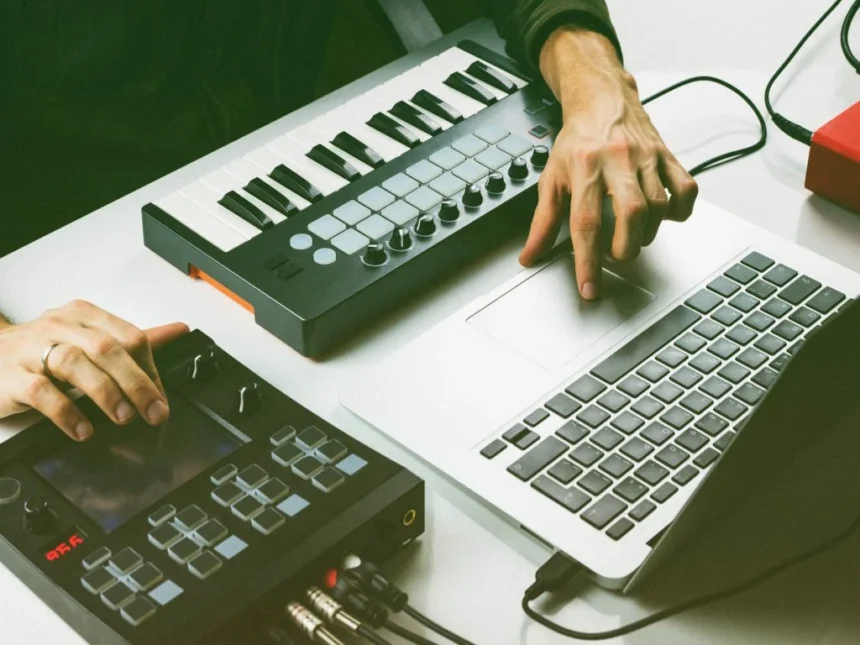You’re in the zone. The melody is perfect, the drums are locked in, and you’re about to sing a part that sounds like magic. You hit record, and then the rainbow wheel, the spinning beachball of death, and the “Disc is too slow or System Overloaded” error show up. Your creative flow comes to a halt. The time has passed.
You’re not the only one who feels this way. In the world of modern music production, we have to deal with huge multitrack projects, sample libraries that take up a lot of space, and plugins that use a lot of processing power. Your storage is the unsung hero—or the silent villain—in this whole thing. Your computer’s internal drive, which used to be a huge empty space, can quickly become a bottleneck that stifles your creativity and even puts your whole career at risk.
Choosing the right external hard drives is one of the most important gear decisions you’ll ever have to make. It may not be as exciting as a new microphone or an old synthesiser, but it is the most important part of your digital studio. This guide will teach you everything you need to know, from the basic technology to professional workflows, so you can keep your mind on the music and not your computer.
Why the internal drive on your laptop isn’t enough for making music
At first, it makes sense to keep everything on the main drive of your computer. It’s all in one place: your Digital Audio Workstation (DAW), your plugins, your project files, and your samples. But as your projects get more complicated, this one-drive setup quickly becomes a big problem for performance.
Imagine a single hard drive trying to run your whole music production setup like a librarian trying to get books from different parts of a huge library for a lot of people at the same time. They need to run to the “Operating System” section, then sprint to “DAW & Plugins,” grab a few “Sample Libraries,” and at the same time find the exact “Project File” you’re working on so they can write new information to it. It’s messy and not very useful.
This is why many professional producers use a multi-drive strategy. A common setup is
Internal Drive: This is where your operating system (macOS or Windows) and your apps (DAW, plugins, etc.) are stored.
External Drive #1 (The “Session” Drive): This is where you keep and run the files for your current project. Your DAW is writing audio data to this drive when you hit record.
External Drive #2 (The “Library” Drive): This drive holds all of your huge sound libraries, like Kontakt, Omnisphere, Spitfire Audio, and others. This is where your computer gets the patch when you load it.
External Drive #3 (The “Backup/Archive” Drive): Use this drive to back up your important files and finished projects.
You get rid of the bottleneck by putting these tasks on different drives. Your system can read and write data at the same time without getting overwhelmed because each drive has a more specific job. This makes playback smoother, lowers latency, and gets rid of those annoying error messages. This article from Sound on Sound gives a great overview of how to manage studio data.
The Big Debate: SSD or HDD for Making Music
The first big decision you’ll have to make when you start looking for external hard drives is whether to get a Solid State Drive (SSD) or a Hard Disc Drive (HDD). It’s not about which one is “better” in general; it’s about which one is better for a certain job.
HDD (Hard Disc Drive): The Workhorse
HDDs are the old-fashioned drives with spinning platters. A mechanical arm writes data to a magnetic disc that spins inside.
- Pros:
- Huge Storage Space at a Low Price: This is the HDD’s best feature. You can get hard drives with multiple terabytes (4TB, 8TB, even 16TB) for a lot less than an SSD with the same amount of storage.
- Proven Technology: They have been around for a long time and are a safe choice for storing things for a long time.
- Disadvantages:
- Slower Speeds: Because HDDs are mechanical, it takes longer to find and move data. When you try to stream hundreds of audio tracks or load big virtual instruments, this can be a problem.
- Fragile: Because they have moving parts, HDDs can be damaged if they are dropped or bumped. This is a big worry for a producer who travels.
- Noise: The moving arm and spinning platters can make noise that can be heard, which isn’t good in a quiet studio.
Best Use Case for Music Production: HDDs are great for making backups and storing data. Because they cost so little per gigabyte, they are the best way to store all of your finished projects, raw multitracks, and sample libraries that you don’t use in every project. They are your digital safe.
SSD (Solid State Drive): The Fastest
There are no moving parts in SSDs. They use flash memory, which is like the storage on a USB stick or your phone, to store data, which makes it easy to get to.
- Pros:
- Incredible Speed: This is the thing that changes everything. SSDs can load big sample libraries in seconds instead of minutes. They can easily handle a lot of tracks, which makes your whole music production workflow feel faster and more responsive.
- Durability: With no moving parts, they are far more resistant to shocks, vibrations, and drops—a must-have for producers on the go.
- No Noise: They don’t make any noise.
- **Drawbacks:
- Higher Cost: Even though prices are going down, SSDs are still a lot more expensive per gigabyte than HDDs. A 4TB SSD can cost a lot more than a 4TB HDD.

Best Use Case for Music Production: SSDs are the best choice for tasks that need high performance. Use an SSD as your “Session Drive” for projects that are currently in progress and as your “Library Drive” for the virtual instruments you use the most. You will notice the difference in speed every day.
The Decision? It’s a partnership, not a competition.
A hybrid approach is the best way for any serious producer to go. Make a system that works well and costs less by using the best parts of each technology:
For your active projects and sample libraries that you use a lot, use a fast external SSD with at least 1TB to 2TB of space.
For long-term storage, backups, and keeping older projects safe, use a large external hard drive (4TB or more).
This gives you lightning-fast performance where it matters without costing a lot of money for storage. You can use this useful tip right away to make your studio work better.
Important Features to Look for in an External Hard Drive
There are a few important technical specs that will affect how well a drive works, in addition to SSD vs. HDD.
Type of Connection: Thunderbolt vs. USB
The port you use to connect the drive to your computer is like a highway for your data. Even the fastest drive will slow down if the connection is slow.
Thunderbolt (3, 4, and 5): This is the best way to make music, especially on Mac computers. It has a very high bandwidth (40 Gbps for Thunderbolt 3/4), so it can handle huge data streams from multitrack audio and sample libraries at the same time with very little delay. Using a Thunderbolt drive is the best way to get the most out of your computer if it has a Thunderbolt port.
USB (3.2 Gen 2, USB4): Don’t forget about modern USB! The Thunderbolt 3 protocol is built into USB4, which can reach speeds of up to 40 Gbps. USB 3.2 Gen 2 can reach speeds of 10 Gbps. A 10 Gbps connection is more than enough for most external SSDs to reach their full speed.
Tip: Look at the ports on your computer before you buy a drive. If you only have a slow USB 2.0 port, buying a super-fast Thunderbolt drive is a waste of money. Make sure the drive works with the fastest port on your computer. This TechRadar article is a great place to learn more about the details.
Speed (RPM for HDDs, Read/Write for SSDs)
For HDDs: The speed is measured in revolutions per minute (RPM). If you want to make music, the minimum speed for a drive you plan to work from is 7200 RPM. 5400 RPM drives should only be used for slow, long-term storage. The drive can find and send data faster because it spins faster.
For SSDs: Reading and writing data speeds are measured in megabytes per second (MB/s). If you want an external SSD, it should have speeds of at least 500 MB/s. Models that use NVMe (Non-Volatile Memory Express) technology and are very fast can reach speeds of over 1,000 MB/s or even 2,500 MB/s. This is amazing for loading orchestral libraries or editing sessions with a lot of tracks.
Capacity: How Much Room Do You Really Need?
Audio files are large. A 24-bit, 44.1kHz mono audio file is about 7.5 MB per minute. Before you even bounce the final mix, a 5-minute song with 50 tracks can easily be several gigabytes. Sample libraries can take up a lot of space on their own, like 50GB, 100GB, or even a terabyte.
Starter (Project Drive): 1TB is a good place to start.
Serious Producer (Project + Library Drive): 2TB to 4TB is a much safer bet.
Professional/Media Composer (Archive/Backup Drive): 8TB and up.
Useful Tip: Always buy more storage than you think you need right now. Your collection of sounds and projects will only get bigger. It’s much better to have extra space than to run out in the middle of an important project. You will be grateful to yourself in the future. If you need help putting together your whole setup, read our guide on Home Studio Essentials.
Our Top Picks: Best External Hard Drives for Music Production in 2025
These are some drives that professionals in the field trust and that would be great for any studio.
Samsung T7 Shield is the Best SSD Overall
The Samsung T7 Shield is a great all-around device. It has read and write speeds of about 1,000 MB/s, a tough case that won’t break if you drop it or get it wet, and it comes in sizes of 1TB, 2TB, and 4TB. It connects to computers through USB 3.2 Gen 2, which means it works with a lot of them. This is the best drive for a session or a portable library.
LaCie d2 Professional is the best high-capacity HDD.
In professional studios all over the world, you will see the blue light of a LaCie d2 drive. People talk about how reliable they are all the time. The d2 Professional is a powerful workhorse that spins at 7200 RPM and comes in huge sizes (up to 20TB). It works with both USB-C and Thunderbolt 3. This is the best drive for your sample library and your long-term project archive.
The SanDisk Extreme Portable SSD V2 is the best for portability.
The SanDisk Extreme Portable SSD is a great choice if you work, travel, or perform live with your laptop. It’s small, very strong, has a carabiner loop to attach it to your bag, and can send data at speeds of over 1,000 MB/s. You can put it in your rucksack without worrying about it.
The OWC Envoy Pro FX is the best performance (NVMe)
The OWC Envoy Pro FX is a beast for producers who need the best performance money can buy. It is a portable NVMe SSD that uses Thunderbolt to reach speeds of up to 2,800 MB/s in the real world. It is also very strong and has been tested to be dustproof, drop-proof, and waterproof. It feels like it takes no time at all to load a huge, complicated orchestral template from this drive.
Helpful tips for using external hard drives in your work
Getting the right drive is only half the battle. How you use it every day is what really protects your music and makes your work easier.
The 3-2-1 Backup Plan: Your Job Depends on It
This can’t be changed. It’s not a question of “if,” but “when” data loss will happen. The 3-2-1 rule is the best way to stay safe:
- 3 copies of your information.
- On 2 different kinds of media.
- With one copy kept off-site.
How a Producer Can Use This:
- Copy 1 (Working Copy): The file for the project you’re working on right now on your external SSD.
- Copy 2 (Local Backup): A backup of that project to your external hard drive every day or week.
- Copy 3 (Off-site Backup): This is a backup to a cloud service like Backblaze or Dropbox, or to a physical drive you keep somewhere else, like a friend’s house or a studio.
You won’t lose years of hard work if there is a fire, theft, or drive failure.
A Way to Stay Sane: Organising Your Files
A mind is as messy as a drive. Make a folder structure that is clear and consistent, and stick to it. This saves a lot of time that would have been spent looking for that one bounce or snare sample.
**How to Set Up Your Project Drive:DRIVE:\_MUSIC_PROJECTS\└── ARTIST_NAME_-_SONG_TITLE\├── 01_AUDIO├── 02_MIDI├── 03_SAMPLES_AND_PRESETS├── 04_PROJECT_FILE├── 05_BOUNCES└── 06_NOTES
This simple structure makes it easy to find or archive any project on its own. Do you want to know what DAW to use for these projects? Check out our ideas on Choosing the Best DAW.
Basic Drive Maintenance
Always Eject Properly: Don’t just pull the cable out. This could mess up the data you were just working on. In your operating system, use the “Eject” or “Safely Remove Hardware” option.
Keep your firmware up to date: Sometimes, manufacturers release firmware updates to make things work better and more reliably. Look at their website from time to time.
Run Health Checks: Every few months, use the built-in disc utility tools on your computer (Disc Utility on Mac and Error Checking on Windows) to look for problems.
Conclusion: Putting money into the base of your music
In the exciting world of music production, it’s easy to get too focused on the tools that make sound. But the tools that store and manage that sound are the most important part of your whole creative process. One of the best things you can do to improve your studio is to invest in a smart external drive strategy that combines the speed of SSDs for performance with the low cost of HDDs for safety.
It’s an investment in peace of mind, stability, and speed. You can get rid of technical problems, protect your life’s work, and focus on what really matters: making amazing music by choosing the right external hard drives and setting up a professional workflow.

